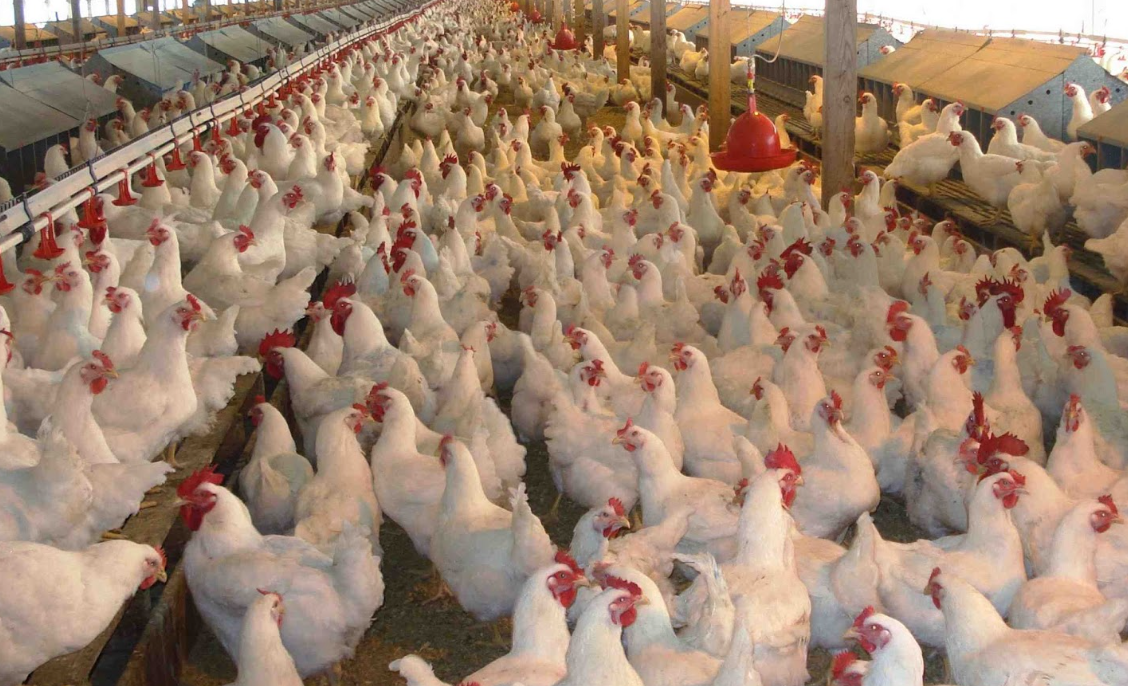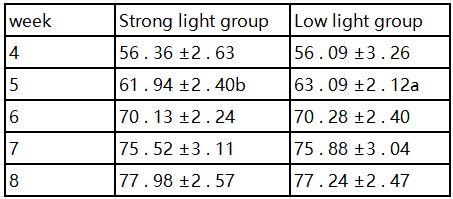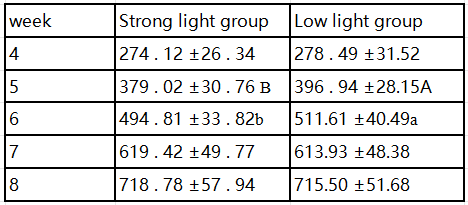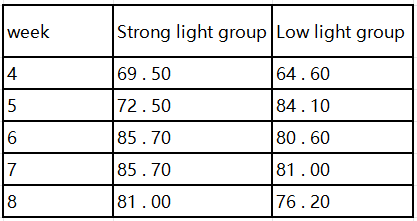Effect of Chicken House Lights Intensity on Growth Performance

Directory:
1. Materials and Methods
2. Results and Analysis
3. Discussion
4. Conclusion
Lighting duration and intensity are crucial environmental factors in the farming of laying hens, significantly influencing the growth and development of chicks and young chickens. Research, both domestic and international, has primarily examined how light intensity affects the egg-laying performance of hens, and these findings have been implemented in practical production settings. Currently, China's laying hen production operates under a "small scale, large group" model, where small-scale farmers and large-scale intensive operations coexist. Most laying hens are raised in semi-open chicken houses, utilizing a combination of natural and artificial lighting. However, the natural light often results in light intensity levels that exceed the optimal range for chicks, with significant variations in intensity across different areas and levels within the house. While numerous studies have explored the effects of varying light intensities in open or semi-open chicken houses on the production performance of laying hens, there is a lack of research on how different light intensities within chicken houses impact the growth performance of chicks. The brooding period is critical for determining the overall success of the laying hen breeding cycle, and light is a key environmental factor for chicks. Given that chicks tend to feed more in well-lit areas, this experiment aims to investigate how different light intensities in chicken houses affect the growth performance and weight uniformity of chicks by measuring their weight, shank length, and weight consistency. The goal is to provide insights for future feeding and management practices for laying hens.
1. Materials and Methods
1.1 Experimental Design
The study was conducted in a semi-open chicken house featuring 4 rows and 5 aisles, capable of accommodating 10,000 chicks. Lighting was provided by 5 W incandescent bulbs, arranged in a row above each aisle with a spacing of 4 meters between bulbs. The lighting schedule adhered strictly to the management guidelines for laying hens. Eight measurement sites were chosen within the chicken house: four near the light window and four further away. Light intensity at the upper, middle, and lower levels was recorded weekly using a light meter (TES-1330A, TES Electronics Co., Ltd.), with measurements taken at the height of the chicks' eyes for each layer. The chicks were categorized into two groups based on light intensity: a strong light group (average intensity: 84.10 ± 66.67 lx) and a weak light group (average intensity: 3.42 ± 2.44 lx). Each group consisted of 4 replicates, each containing 60 chicks. A total of 480 Hy-Line Brown chicks, 28 days old and recently transferred, were selected for a 28-day experimental period. Weekly measurements of the chicks' weight and shank length were taken using an electronic platform scale (EX - ALH - C, Shanghai Yinzhan Electronic Enterprise Co., Ltd.) and an electronic digital caliper (GB/T14899 - 94. Guiyang Hengchang Measuring Tool Co., Ltd.), and weight uniformity was calculated. Weight uniformity (%) = (number of chickens within 10% of the sampled weight / total number of sampled chickens) × 100.
1.2 Feeding and Management
The chicken house utilized a three-layer A-shaped ladder cage system, allowing chicks free access to food and water. Manure was removed using a scraper, the water lines were cleaned and disinfected daily, and the house underwent disinfection twice a week.
1.3 Data Analysis
Data were processed using Microsoft Excel and SPSS 22.0 software for variance analysis. Results are presented as "mean ± standard deviation," with P < 0.05 indicating a significant difference and P < 0.01 indicating an extremely significant difference.
2. Results and Analysis
2.1 Impact of Varying Light Intensities on Chick Shank Length
Table 1 indicates that there was no notable difference in shank length between the two groups at week 4 (P>0.05). However, by week 5. varying light intensities significantly influenced the shank length of the chicks (P<0.05), with the weak light group showing an increase of 1.15 mm compared to the strong light group. Starting from week 6. the difference in shank length between the strong and weak light groups began to diminish, and from week 6 to week 8. there was no significant difference in shank length between the two groups (P>0.05). By week 8. the shank length of the strong light group was slightly greater than that of the weak light group.
table1 Effects of different light intensities on chick shank length

2.2 Impact of varying light intensities on chick weight
Table 2 indicates that during the 4th week, there was no notable weight difference between the weak light group and the strong light group (P>0.05). However, in the 5th week, the weak light group showed an increase of 17.92 g compared to the strong light group, which was statistically significant (P<0.01). Starting from the 6th week, the weight difference between the two groups began to decrease. In the 6th week, the strong light group weighed 16.80 g less than the weak light group, a significant difference (P<0.05). By the 7th and 8th weeks, the strong light group had a slightly higher weight than the weak light group, but this difference was not significant (P>0.05).
2.3 Influence of different light intensities on the consistency of chick weight
According to Table 3. in the 4th week, the strong light group exhibited slightly better weight uniformity. In the 5th week, the weak light group had a weight uniformity that was 11.60 percentage points higher than that of the strong light group. Following this, the disparity gradually decreased, with the strong light group's weight uniformity improving. From the 6th to the 8th week, the strong light group consistently showed slightly better weight uniformity than the weak light group, with differences of 5.10. 4.70. and 4.80 percentage points, respectively.
table2 Effects of different light intensities on chick weight

table3 Effects of different light intensities on the uniformity of chick weight

3. Discussion
3.1 Variations in Chicken Houses Light Intensity
In a single chicken coop housing the same group of chickens, while the duration of lighting can be uniform, the light intensity experienced by each chicken varies. The dimensions of the chicken coop significantly influence light intensity, particularly in a three-tier full-step cage system for laying hens, where chickens in different cages receive inconsistent light levels. This study was conducted during the rearing of chicks, revealing that chicks exposed to light spots tend to eat more. Consequently, the research investigated how varying chicken houses light intensities affect the growth performance of chicks. By measuring light intensity and categorizing it into strong and weak light groups, the experiment demonstrated a highly significant difference in light intensity between these groups (P<0.01), with the strong light group receiving 40 to 85 times more light than the weak light group. Both excessively strong and weak light can negatively impact chickens. Intense light can lead to severe pecking and anxiety, making it economically unfeasible, while insufficient light can hinder the growth performance of chicks and the productivity of laying hens. However, the optimal light intensity varies depending on the age and type of chicken. Therefore, in practical egg and broiler production, supplemental lighting and darkening techniques are frequently employed to regulate the chicken houses light intensity to the appropriate levels.
3.2 Impact of Varying Light Intensities on Chick Growth Performance
The right chicken houses light intensity significantly enhances the metabolism, growth, and development of chicks. Current production standards recommend a stronger light intensity of about 10 to 20 lx for newborn chicks aged 1 to 2 weeks, as they have not fully developed physiologically and have limited vision. In this study, it was observed that the tibia length of chicks in the weak light group was notably greater than that of those in the strong light group by the 5th week (P < 0.05). However, by the 6th week, the difference began to diminish, and there was no significant difference in shank length between the two groups (P > 0.05). The body weight of the weak light group was significantly higher than that of the strong light group in both the 5th week (P < 0.01) and the 6th week (P < 0.05). After the 7th week, the difference in body weight was no longer significant (P > 0.05). This suggests that excessively high light intensity may adversely affect the growth performance of chicks during the first six weeks. However, after the 6th week, the chicks may have adjusted to the chicken houses light intensity, resulting in no significant impact on their growth performance thereafter. Wang Changping et al. also noted that light intensity significantly influences feather pecking behavior in laying hens during the brooding period; as chicken houses light intensity increases, behaviors such as feather pecking, grooming, foraging, drinking, standing, and walking also increase, while feeding and resting behaviors decrease, potentially hindering growth performance, which aligns with the findings of this study.
3.3 Impact of Varying Light Intensities on Chick Weight Consistency
Research indicates that light intensity significantly affects chickens. For laying hens, a high light intensity of 15-40 lx is recommended during the chick stage, as this period is crucial for rapid growth and development. Such chicken house light intensity aids in feeding and metabolism, enhances the absorption of calcium and phosphorus for healthy bone growth, boosts vitality, and improves feed conversion rates. In this experimental study, it was observed that the weight uniformity of chicks in the low light group during the fifth week was greater than that of the high light group, with a significant difference noted. However, from the sixth week onward, the weight uniformity in the high light group surpassed that of the low light group, although the difference was not statistically significant. Du Yongsuo et al. found that starting from the seventh day of age, as long as the chicken houses light intensity remained within an appropriate range, weight uniformity among laying chicks was unaffected, aligning with the findings of this study. Conversely, Rahimi et al. reported that excessive chicken houses light intensity heightened chicken activity and increased feed consumption, while lower light levels could reduce feed intake and enhance productivity. These variations may stem from differences in breed, age, feeding practices, light intensity, and duration.
4. Conclusion
From this experiment, the following conclusions can be drawn:
(1) Chicken houses light intensity significantly influences chick growth performance. In the fifth week, the weak light group (3.42 ± 2.44 lx) exhibited better growth performance and weight uniformity compared to the strong light group (84.10 ± 66.67 lx). After six weeks, no significant differences were observed between the two groups, although the strong light group showed a tendency for better performance.
(2) Chicken houses light intensity levels can vary widely. Therefore, semi-open chicken houses should prioritize controlling light intensity to enhance the growth performance and weight uniformity of chicks.
5. Related Blog
Effects of LED Poultry Lights On The Growth of Fast-growing Broiler Chicken
The Effect of Light in the Chicken Coop on Poultry Farming Production